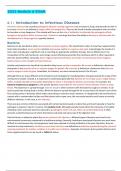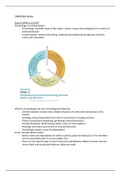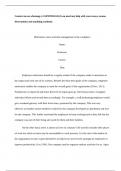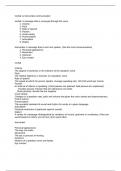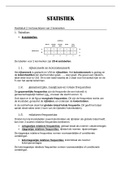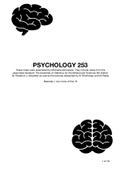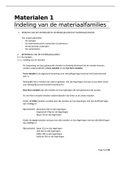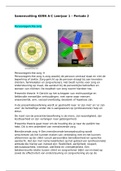6.1 : Introduction to Infectious Diseases
Infectious diseases are caused by pathogenic (disease -causing) organisms such as bacteria, fungi, and parasites as well as
by viruses. Bacteria are defined as single -celled microorganisms . They can be found virtually everywhere and can either
be harmless or very dangerous. This module will focus on the role of antibiotics to eliminate the pathogenic effects
brought on by bacteria within a human host . Antibiotics are drugs that have the ability to destroy or interfere with the
development of a living organism , typically bacteria.
Bacteria
Bacteria can be classified as either Gram -positive or Gram -negative . This classification refers to how they respond to the
Gram stain procedure. Gram -positive bacteria stain purple , and Gram -negative stain pink . Interestingly, the results of a
Gram stain actually play a significant role in selecting an appropriate antibiotic therapy. Due to differences in the
composition of the cell membrane, some drugs cannot effectively penetrate the membrane which is often required to
elicit the desired effects. Generally, Gram -negative bacterial infections are harder to treat because Gram -negative
bacteria have a more complex cell wall structure .
Another way bacteria are classified is by whether they are an aerobe or anaerobe . An aerobe is defined as a bacterium
that grows in the presence of air or requires oxygen for growth. An anaerobe is defined as a bacterium that does not
require oxygen in order to grow. Anaerobes, for instance, are most commonly found in the GI tract.
Although there are many different kinds of bacteria and strategies for classifying them, this goes beyond the scope of this
introductory module. Instead, it is important to understand generally tha t bacteria do not simply cause a single disease:
rather, multiple disorders are possible depending on where in the body the bacteria accumulate . For example, the
bacteria streptococcus pyogenes is the specific bacteria responsible for the common throat infection known as strep
throat . This bacterium is spread through airborne droplets when someone with the bacteria coughs or sneezes. It can
also be spread by sharing food or drinks. When the bacteria spread through the air or even food, the throat is one of the
first contact points in the body, which makes strep throat a common result. However, if it happened to be transferred via
contact with a contaminated surface and the person had an open sore, the very same bacteria could cause an entirely
different infection, in this case, a skin infection .
There are also common infections associated with certain bacteria based on where they are found naturally or how the
pathogen is acquired. Take for instance, the bacteria E.coli . Although typically found within the intestines of a healthy
individual, when someone becomes exposed to a pathogenic strain of E.coli, often via contaminated food, it often
presents as diarrhea because of where the bacteria naturally end up by way of the digestive tract.
One last factor is related to where the person contracts the infection —different types of bacteria are found in the
environmental community compared to a healthcare setting. Generally, healthcare -associated infections are much more
difficult to treat because the microorganisms have been exposed to strong antibiotics in the past; therefore, they are
resistant to many treatments. Healthcare -associated infections are defined as an infection acquired during the course of
receiving treatment for another condition in a health care institution . Examples of common Gram -positive bacteria and
Gram -negative bacteria can be found in Table 5.1 below.
1 / 2
Important terminology to be familiar with regarding antibiotics and bacteria:
Antibiotic spectrum - bacteria that are susceptible to the antibacterial actions of a particular drug .
Broad Spectrum is defined as an antibiotic that is effective against a wide variety of both Gram -positive and Gram -
negative bacteria .
Bacteria Resistance is defined as the ability of some bacteria to resist the actions of antibiotics .
MRSA stands for methicillin -resistance Staphylococcus aureus. Methicillin is a penicillin -related antibiotic that was
previously effective against resistant staph infections. However, over time, an even more drug -resistant strain developed
and was termed MRSA . MRSA infections have become a major problem because none of the penicillin -class drugs are
effective against it. In fact, only a few antibiotics, such as Vancomycin, have demonstrated effectiveness.
6.2 : Antibiotics
Similar to other types of medications, antibiotics are classified into broad categories or classes . These classifications are
most often based on their chemical structure ; however, these classes vary in more ways than just their chemical
structure. Distinguishing characteristics include antibacterial spectrum, mechanism of action, potency, toxicity, and
pharma cokinetic properties. Antibiotics are different than most other drugs in that their targeted site of action is not a
part of the body but is actually the foreign bacteria that is causing an infection . The ultimate goal of the drug treatment
is to kill or destroy the bacteria causing harm.
There are four common mechanisms of action associated with antibiotics:
1. Interference with bacterial cell wall synthesis . This causes the formation of defective cell walls within the
bacteria that are unstable and easily broken down. This generally causes the bacteria cell to rupture and
ultimately die.
2. Interference with protein synthesis. Without the ability to make proteins, the bacteria can no longer function.
3. Interference with replication of DNA and RNA . DNA and RNA replication are how bacteria cells multiply. If they
are not able to multiply, then the infection cannot survive.
4. Antimetabolite action that disrupts important metabolic reactions within the bacterial cell. By inhibiting
important metabolic activities, the bacteria are no longer able to grow and function properly.
Antibiotics are either considered bactericidal or bacteriostatic .
Bactericidal antibiotics work by killing the bacteria.
Powered by TCPDF (www.tcpdf.org)
2 / 2

